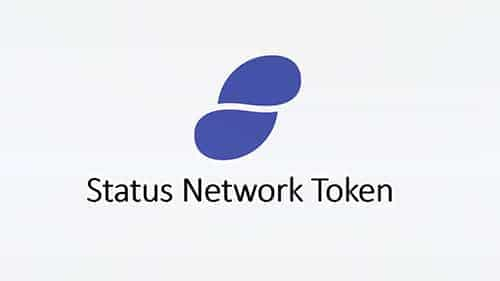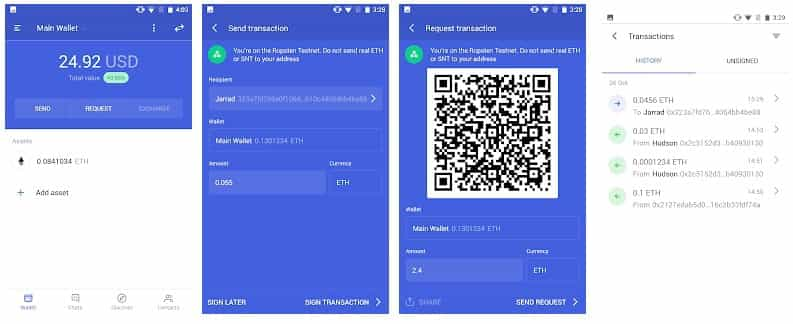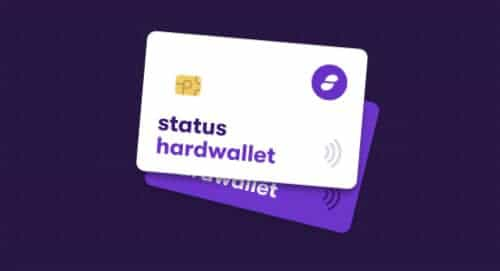Review of Status (SNT): The Ethereum Powered Mobile OS
Status is a unique concept that will either change the landscape for the Ethereum network, or fade into obscurity if it doesn’t deliver on its promise.
That promise is becoming increasingly ambitious, but the original design of Status is as a mobile operation system, decentralized browser, and messaging system similar to WeChat. Built on top of the Ethereum network, Status will allow you to interact fully with that network right from the palm of your hand.
Status operates as a light client Ethereum node, and as such it gives you access to all of the Ethereum decentralized applications (dapps) right through an app installed on your mobile device. Because it is focused on the fastest growing technology – mobile – it has opened the door to the potential for mass adoption of dapps based on Ethereum.
Where desktop users have relied on MetaMask for interacting with the Ethereum network, mobile users will come to rely on Status, if the developers have their way.
Status Team
What started with a handful of developers has grown to over 40 full-time team members, with most focused on the development of the core application, while others look to create new dapps. There are also members devoted to marketing, legal compliance and community management.

The Status Network was founded by a pair of developers who have a long work history together. Carl Bennets and Jarrad Hope previously ran a software distribution company together, and used the funds from that venture to bootstrap Status until its ICO in June 2017.
Since the ICO, Status added former Google executive Nabil Nahdy to the team as Chief Operating Officer. Nabil led the Google Maps and Google Flight products while at Google and brings his experience in developing products with a user base in the billions.
Nabil is responsible for creating the Status vision, a roadmap, and the product itself as it moves from alpha to beta, and finally to the production product.
Reinventing Social Networks
The current social network architecture leaves all of the power in the hands of the owners and advertisers on the network. The users are actually left with very little power over the direction the platform takes and even their own personal information and how it is shared.
Status seeks to break that model and move to one that gives the power back to the people. Through the use of the Status Network Tokens (SNT), Status will make all the network users stakeholders as well. This will better align the goals of the social network with the goals of its users.
It will also return control of personal information to the users, and give them a voice in the development and evolution of the network. To further that vision, Status Network was created as an open-source platform, where anyone can develop new dapps to run in its ecosystem.
Status Network Token (SNT)

The Status Network Token (SNT) was created as a utility token to fuel transactions on the Status Network.
While the network is free to use and communicate through, SNTs are necessary to access some features on the mobile Ethereum client. As stakeholders, SNT owners will also have the ability to help shape the development and direction of the Status project.
Status Usernames
Currently Status uses SECP256k1 public keys as usernames, but the Status team has been working with Nick Johnson, one of the co-creators of the Ethereum Name Service, to develop a public key resolver that will allow for the use of regular usernames on the network.
One decision made by the Status team is to only allow SNT holders to create usernames. This is being done to cut down on spam accounts. In a similar fashion to the way Twitter uses verified badges to add account trust, Status will have badges to show account trust.
These badges will be distributed to those that deposit a set amount of SNT against their username as a bond of sorts. The badges will display the number of tokens being used as backing as well as the number of backers associated with the account.
Mobile Ethereum Client
The Status Network remains in alpha currently, but application clients are available for both Android and iOS. The Android version can be downloaded right from the Google Play store.

If you’re an iOS user you’ll need to request the iOS version from the Status website.
Status Features
The current features are good, but the real promise in Status lies in the future. As an open source blockchain platform that can connect to any Ethereum dapp the possibilities are without limit.
Below are the already implemented features:
Decentralised Push Notification Market
These come with both benefits and one big downside. The benefits are that the user can decide which network nodes are providing them service, you can decide which push notification providers to use, and you are able to set your own privacy levels and opt in or out of any push notification service.
This flexibility and privacy comes at a price though. Status has you pay for any push notification service, unlike traditional social networks, where push notifications are “free”. They aren’t really free though, since you’re paying with your data, and the ability for advertisers to contact you.
Governance
The traditional social networks give users very little say in the evolution of the network. With the Status Network, every SNT holder has a direct influence over network changes, and can propose new changes as well.
Whenever there is a decision to be made on the network each SNT holder will receive Decision Tokens equal to the number of SNTs held. These decision tokens are used to vote and there is no SNT cost for voting.
Community Curation
This allows SNT holder to upvote and downvote the content that displays in the Status application, similar to the way users upvote and downvote on Reddit or Steemit. Voting power here is determined by the number of SNT held by the voter.
Tribute to Talk
Stakeholders are able to set a minimum amount of SNT that a Status user must deposit as a tribute for someone outside of their network to contact them. To message a stakeholder, a user must first deposit the required amount of SNT declared by the “Tribute to Talk” recipient.
If the recipient replies to message, the recipient will also receive the deposited tributed amount posted by the original messenger.
Available DApps
Staus already supports some of the most popular Ethereum SApps and more are on the way. Below is the list of supported DApps and their usage:
uPort – This is a self-sovereign identity system that allows users to declare digital independence.
Gnosis – A prediction market that harnesses the wisdom of the crowd.
Oasis Exchange – A decentralized digital asset exchange that allows for nearly instantaneous exchange between ETH and any ERC-20 asset.
Ethlance – Decentralized freelance jobs marketplace.
Aragon – Create decentralized organizations or companies without borders.
Etherisc – An insurance platform that allows users to buy policies in a decentralized fashion, and get paid for claims automatically.
Ujo – Artists gain control over your creative assets and share them with the world.
Proposed Features
The Status whitepaper proposes a number of additional features to be added in future implementations. Here are the big three:
Status Teller Network
A decentralized app that will live inside Status, it will allow stakeholders to find counter-parties to exchange fiat currencies for digital currencies. Similar to services such as LocalBitcoins, it will allow anyone with a smartphone to easily exchange cash for crypto.
Decentralized Application Directory
With the number of Dapps already growing rapidly, and poised to explode once mainstream adoption brings Ethereum to the masses, Status has planned to created a directory of decentralized applications, which will be member curated.
This will be similar to the Google Play store or the Apple App store and will allow users to quickly and easily find decentralized applications that meet their needs.
Sticker Market
Stickers have been well-documented to increase user adoption and interaction, and the Status sticker market would allow anyone to design and sell their sticker creations globally. This is similar to the LINE sticker market, which accounts for over $250 million in annual revenue.
Status Hardware Wallet

Status released a hardwallet in November 2017. It is unique in that unlike other wallets that require a wired connection, the Status hardwallet will allow you to store, send and receive any ERC-20 tokens, as well as most other cryptocurrencies, without a wired contact, through built-in NFC.
The hardwallet is mobile ready, and is open-source so the code can be modified to meet any need. The hardwallet is currently in beta and access to test it can be requested here.
Open Bounties
Also in November 2017, the Status team announced its Open Bounty program that is an open-source collaboration marketplace for developers and organizations to connect.
The Open Bounty program lists projects that developers can contribute to and be paid in the ERC-20 cryptocurrency of their choice, avoiding the fees imposed by traditional banking with fiat currencies. Organizations can also list their own bounties to find just the right talent for projects, quickly and easily.
ICO and SNT Performance
Status ran an ICO in June that was meant to run for several weeks, but hit its hard cap within several hours, raising $99 million dollars. SNTs were distributed at a ratio of 10,000 SNT per 1 ETH.
Status has a total supply of 6,804,870,174 tokens, of which 3,470,483,788 are currently available.
Initially trading at $0.05 when first listed in July 2017, SNT is currently priced at $0.96628 as of May 2018, for a nearly 100% return in less than a year. It has been a wild ride though, and the SNT token traded as high as $0.65 in December 2017 before dropping throughout much of 2018 as the overall crypto markets suffered a bear market.

The most liquid SNT market can be found on IDAX, although SNT can also be purchased on the Binance exchange, Upbit, OKEx, HTX, Bittrex, and many other smaller cryptocurrency exchanges.
As an ERC-20 token, SNT can be stored in any ERC-20 compatible wallet such as MyEtherWallet or MetaMask. Because security is key with cryptocurrencies, you may want to consider storing your tokens in a hardware wallet such as the Trezor or Ledger Nano S.
Conclusion
While Status is a mobile application at its core, the functionality and features it delivers makes it far more than that already, and future development of new features is nearly unlimited thanks to the open-source nature of the code and the ability for developers to create any Dapp they can envision.
Plus, Status taps into all the Dapps being created for the Ethereum network, and this is likely to be huge in the coming years.
As a re-imagined social network that puts the power back into the hands of the individual, Status could well be the game changing platform that blockchain has been waiting for, or it could be a huge bust if it fails to deliver on its promises.
Developments look promising so far, but no one knows for sure what the future might hold.
Disclaimer: These are the writer’s opinions and should not be considered investment advice. Readers should do their own research.
